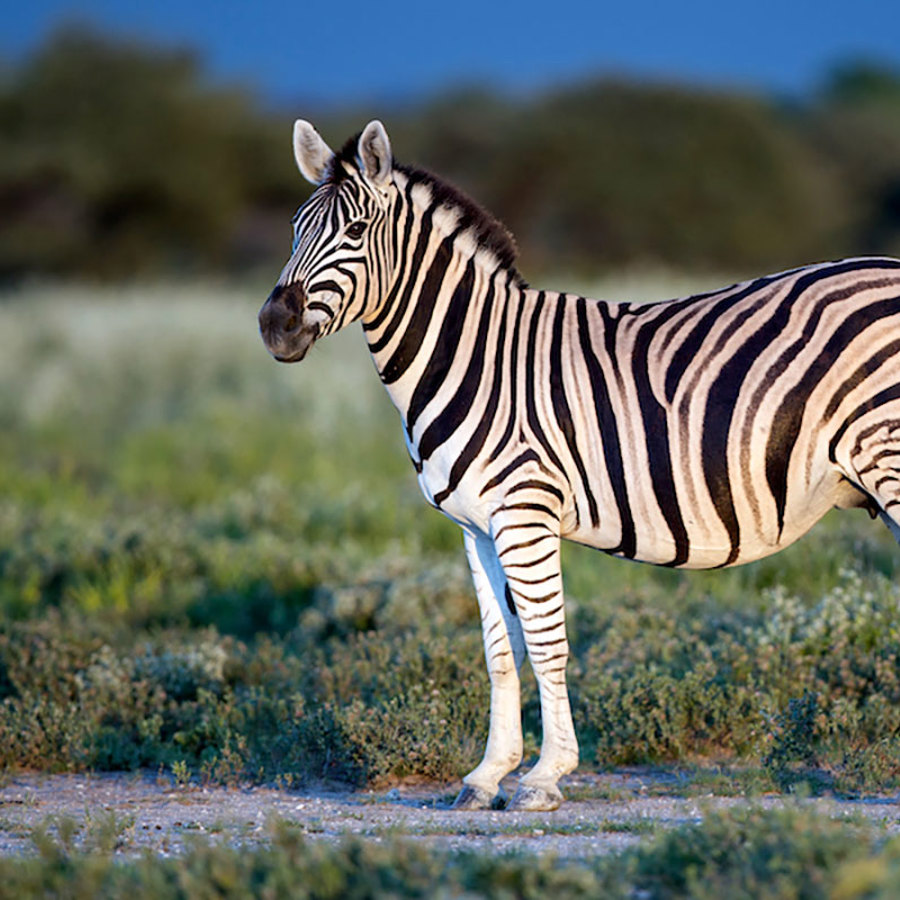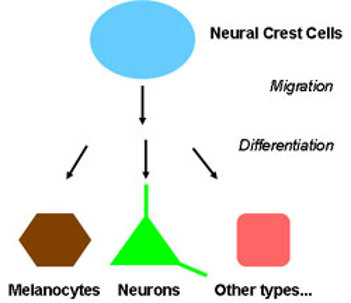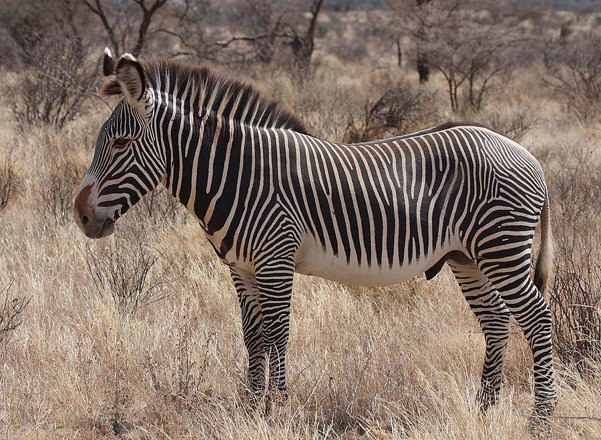
Why do zebras have two different colors? What color is dominant?
August 31, 2011

- Related Topics:
- Quirky questions,
- Developmental biology,
- Dominant and recessive
A high school student from Ohio asks:
“Why do zebras have two different colors (black and white)? What color is dominant or recessive?”
Great questions! And not necessarily that easy to answer...
First, most likely black is dominant over white. This makes sense since it is usually the case that a loss of something is recessive to having it. And stripes are white because of an absence of pigment.
But for zebras it also makes sense that dark is dominant over light because they have darker skin. So zebras are almost certainly black animals with white stripes.

Now the why they have black and white stripes is a little trickier. We understand pretty well why a stripe is white and why it is black. And why different species of zebras have a different number of stripes.
What we don't yet understand is exactly how it happens. But I am happy to go into what we do and don't know.
As you'll see, it has to do with cells that move during development. And when those cells mature.
Color Comes from Cells Called Melanocytes
Animals are made up of trillions of cells, each of which is the basic unit of life. There are over 200 different kinds of cells in our body. And each type has a specific function.
The important one for our discussion here is called a melanocyte. Melanocytes are the cells that produce color or pigment.
In black stripes, these melanocytes are on, cranking out lots of pigment. White stripes have melanocytes too, but they're not making pigment. This makes the stripes appear white.
So black stripes have melanocytes that are on and white stripes have melanocytes that are off. What we don't know yet is why some are on and some are off in a striped pattern.
But we do at least have some idea about why different zebra species have different numbers of stripes. And some reasonable guesses about why some end up on and others off.
The Great Zebra Melanocyte Maturation!
As embryos develop, a certain class of stem cells called neural crest cells (NCCs) moves around the body. Like stem cells, NCCs can turn into other kinds of cells. They go on to develop into melanocytes, neurons (brain cells), bones, and muscle.


Some of these NCCs move along the spine and turn into melanocytes. Then, at some point during zebra development, some are turned on and some stay off.
For melanocytes to crank out pigment, certain genes have to be turned on by other genes in the melanocyte. If the genes do not get turned on, then the cell will not make pigment and is considered off.
Once the gene involved in making color becomes active, the melanocyte is now mature and ready to start making pigment. Depending on when the melanocytes mature will determine how many stripes each type of zebra will end up with in the end.
There are three different classes of zebras: Plains (also called the Commons Zebra), Mountain, and the Grevy's Zebra. Here is a list of each zebra's characteristics and when the melanocytes get turned on and mature:
|
Type of Zebra |
# of Stripes |
Stripe Width |
Week when melanocytes mature |
|
Plains |
26 |
Wide |
3 |
|
Mountain |
43 |
In between |
4 |
|
Grevy’s |
80 |
Narrow |
5 |
From the chart it looks like the earlier the melanocytes mature, the fewer and wider the stripes. To figure out why this is, think about the developing zebra fetus as a balloon.
Let's say we draw even spaced stripes on a small balloon. Now we blow the balloon up a bit. What happens to the stripes?
That's right, they get wide. This is just what is going on with the Plains Zebra.
Now let's draw some stripes on a medium size blown up balloon. At this size there are a lot more stripes that appear narrow like a Grevy's zebra. Mountain zebras fall somewhere in the middle.

This is a simple way to explain why the zebras have different stripe pattern widths. Early maturing melanocytes can spread wide during growth while later developing ones have less time and space to spread.
So, this is what we know. Like I said in the last section, what we don't know is why they start maturing when they do or how the pattern is formed. Or why some turn on and some don't. But one thing we do know, genes are undoubtedly involved.
Genes Need to be ON to Work
The stripe pattern on zebras comes from a process called selective pigmentation. To understand what this means, we need to talk a little bit about genes.
Genes act like an instruction manual and determine many of our traits like eye, hair, and skin color. So it makes sense that the instructions for zebra stripes are in its genes too.
The black or white color comes from whether the pigment genes in the melanocyte are on or off. On means black and off means white.
The pigment genes are turned on or off by other genes. It is these genes that set up the pattern of stripes in a zebra.

What we don't know is how the genes "know" which melanocytes to wake up and which to leave asleep. Undoubtedly, genes that can activate or turn off are involved in controlling pigment genes. However, we are not quite sure which ones are involved.
But researchers aren't totally in the dark. They have figured out how certain striped patterns work in fruit flies. And zebras may use a very similar set of genes.
They've also figured out how genes stay on in one stripe and are shut off in another in fruit flies. Zebras could use a similar mechanism to develop their stripe patterns.
It is also possible that in the developing zebra there is a special signal that attracts the pigmented melanocytes to some areas but not others. This could be kind of like when a coffee-lover smells coffee and is instantly attracted to where the smell is coming from. Except in this case, dark stripe loving melanocytes (those that are on) are attracted to where dark stripes will be.
As you can see, more research is definitely needed. Hopefully now you can appreciate the beautiful, but complex stripes of the zebra!

Author: Dr. Khameeka Kitt
When this answer was published in 2011, Khameeka was a post-doctoral fellow in the Department of Biology, studying initiation and stabilization of epithelial cellular adhesions in James Nelson’s laboratory. Khameeka wrote this answer while participating in the Stanford at The Tech program.
 Skip Navigation
Skip Navigation
